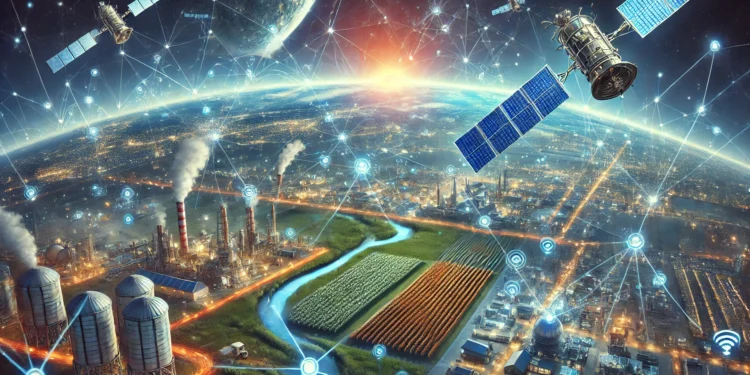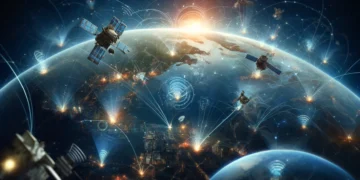Picture a global landscape where cars engage in conversation and, more importantly, share information and access networks at any given locality. This is no longer a dream in the future but a reality brought about by developments in satellites for cars technology. From helping connected cars to providing communication for industries in far regions, satellites have become agents of change in the environment or mobility.
Since automobile manufacturers and remote industries are looking for dependable methods of connecting assets and workforce, satellite solutions are going to be a breakthrough. That is why it is high time we figure out how this evolution is going and what to expect from connected vehicles and satellite IoT solutions in the future.
How Satellites Keep Cars Connected Everywhere?
Smart cars can connect and communicate with other automobiles, peripheral structures, traffic systems, and even home appliances. While terrestrial networks have provided much of this connectivity, there are still plenty of ‘white spots,’ which are not covered well due to difficult terrain or the low population density. This is where satellites for cars come into the picture.
Satellite systems close these connectivity loopholes by providing communication links regardless of geographical location. The advantages of satellite networks do not limit themselves to geographical locations; satellite networks provide higher reliability, security measures, and significantly lower end-to-end latency, which should become mandatory for today’s vehicles.
Why Connected Cars Depend on Satellites
- Global Coverage: Satellite networks do not create dead zones. As long as one is using satellite networks, there is always connectivity all over the world.
- Reliability: Unlike terrestrial networks, satellites can offer service independently of terrible weather or other challenging conditions on the ground.
- Low Latency: Mature IoT satellite communication enables high-speed data transfer, improving the Internet of Things application in areas such as navigation and diagnostics.
Game-Changing Innovations in Satellites for Cars
The evolution of satellites, which has advanced rapidly over the last few years, appears to be paving the way for a new epoch in auto connectivity. All of the above innovations seek to increase the usability, applicability, and efficiency of satellite solutions for transportation and industries.
Key Innovations
- Low Earth Orbit (LEO) Satellites: These satellites are further located and offer prompt communication with little or no lag, which is required for real-time vehicle usage.
- Integrated Networks: Non-terrestrial networks (NTNs), on the other hand, use both terrestrial and satellite networks, which allows for a seamless handover between the two.
- Compact Terminals: Innovations in affordable, compact satellite terminals mean that IoT satellite services are attainable for nearly all types of vehicles.
- AI Integration: Intelligent satellite networks are leveraged to predict when equipment might require maintenance and ensure seamless communication operations.
These enhancements are revolutionizing the probabilities of satellite IoT solutions, allowing them to form the cornerstones of connected cars and remote connectivity.
Satellite Benefits for Industries in Remote Areas
Satellite technology has impacted not only the private vehicle industries but also other businesses. Employment sectors that require connection in remote locations are mining, agriculture, and energy production.
How Private Satellite Networks Support Industries
- Asset Management: These solutions include satellite IoT to detect equipment location and status for better operation.
- Workforce Connectivity: Adequate communication ensures that all employees are protected and synchronized in areas that may be far off or risky.
- Environmental Monitoring: Climates, terrains, and satellite cost data allow for long-lasting ecological work.
Private satellite networks are quickly becoming a lifeline to these industries, connecting the center and the field.
The Growing Role of IoT and Satellites in Cars
With the advanced development of satellite companies in IoT, the future of satellite communication for cars, industries, and more is bright. These firms continue to push the boundaries in delivering flexible solutions depending on individual users’ connectivity requirements.
Contributions of IoT Satellite Companies
- Flexible Models: Telecommunication satellite services should ideally be priced based on subscription or usage since they must appeal to various industries.
- Advanced Integration: Integration with 5G and Edge computing and AI improves satellite networks’ effectiveness.
- Tailored Solutions: Direct custom IoT platforms focus on particular issues and offer the highest value and performance.
Such advancements contribute to increased capabilities of connected car services and facilitate new developments in other applications in emerging markets.
Making Satellite Technology Sustainable
Since the usage of satellite technology continues to rise, environmental conservation is necessary. The satellite industry is thus keen on reducing the effects of its operation on the natural environment in various ways.
Sustainability Trends
- Green Satellites: Employing environmentally sensitive materials and processes to construct and launch satellites.
- Energy Efficiency: Reducing satellite energy consumption while not degrading the overall performance.
- Recycling Initiatives: Designing circular spectra will make it possible to reuse some satellite parts.
Sustainability is deployed here as an innovative strategy that ensures a sustainable future while advancing mobility and connectivity through satellites.
How Automakers and Industries Gain from Satellites
Benefits for Automobile Manufacturers
- Enhanced Vehicle Features: Add real-time navigation and OTA updates, and nearly every connected car application extends satellite networks.
- Safety and Security: Satellite communication encrypts any vital information about the vehicles from possible cyber attacks.
- Global Accessibility: Car manufacturers should be able to build automobiles that can still be connected beyond borders and in areas of longitude.
Benefits for Remote Industries
- Improved Efficiency: Satellite IoT solutions find their application in making processes and workflows more efficient by providing reliable asset tracking and workforce management services.
- Reduced Costs: Therefore, satellite networks make it easier and cheaper for industries that need to venture into remote areas to avoid expensive ground infrastructure.
As all of these advantages become realized, connected cars and remote industries will be key areas for leveled satellite technology.
The Future of Mobility with Satellites for Cars
The potential of satellites for cars is huge, and this is especially due to the fusion of IoT and satellite concepts. As satellite IoT solutions improve, private satellite networks, connected vehicles, and remote industries will experience unprecedented growth.
For automobile manufacturers, this is a new age of invention in which automobiles are not just means of transport but communicators of global connectivity. Specialists explain that satellite connection serves as a lifeline for distant industries since no base of operation, equipment, or personnel is too far away to monitor.
The way to a connected and sustainable society is evident in the future. The journey may not be short, but the prospect of getting there is made brighter and even more exciting with the aid of technology.
Conclusion: Why Satellites Are the Key to Smarter Cars
Satellite for cars is a groundbreaking concept that is giving connectivity a completely new face for automobiles and other sectors. With global coverage, the latest IoT communication satellite technology ensures that the connection leaves no gap to the desired destination.
As advancements in satellite IoT solutions continue to evolve, automobile manufacturers and remote industries stand to benefit immensely. Whether it’s ensuring the safety of a connected car or the efficiency of a remote workforce, the possibilities are endless.
The future of mobility and connectivity is here—and it’s powered by satellites for cars












